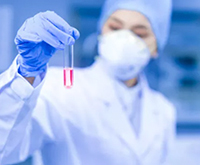Human IgM
Indirect detection of antigens using secondary antibodies offers other advantages besides diversity, flexibility, and versatility:
Allow for the use of the same primary antibody with different secondary antibodies depending on the application.
In some cases, the same secondary antibody can be used across applications (i.e. fluorescent western blot and immunofluorescence) to validate target antigen detection.
Secondary antibodies also offer the ability to perform multiplexing or multi-labeling in experiments.
Human IgM Products
| Antibody | Application |
| Mouse anti-human IgG monoclonal antibody | For immunodiagnostic: ELISA, LFA, CLIA |
Human IgM Intro
Immunological detection is one of the important methods of clinical detection. It is a diagnostic method widely used in clinical detection, diagnosis, and epidemiological investigation. Immunological detection methods use specific and reversible spatial binding between antigens and antibodies to detect targets. Known antigens can detect unknown antibodies, and known antibodies can also detect novel antigens (e.g., serological tests). According to the different detection targets, immunodetection methods can be mainly divided into virus antigen detection and serum IgM/igg antibody detection; Clinically, the detection of IgM-type antibodies can be used as indicators for the early diagnosis of certain infectious diseases.
Serum IgM antibody detection requires reference material (rm) to evaluate quality control and detection methods and kits. However, for human-derived clinical reference materials, many reference material raw materials need to be extracted from the blood of patients, which significantly limits the development of clinical reference materials. If the patient is difficult to find or the blood level is shallow, in vitro expression and purification using recombinant protein technology should be considered.
Positive sera are pooled inactivated sera of patients, not purified by extraction, of very low purity and polyclonal origin (because in addition to serum matrix and antibodies against (viral) antigens, they also contain an extremely high abundance of non-anti-(viral) antigens. presence of background antibodies). At this stage, most reagent companies directly use the positive serum as the quality control product developed for IgM detection. Its defects as a quality control material are that it has biosafety risks and batch source differences, it cannot accurately replicate, nor can it be accurately characterized, and it is impossible to develop reference material with extremely high requirements for purity, stability, uniformity, and accuracy of determination on its basis.
IgM Secondary Antibody
IgM mainly exists in the blood of living organisms and plays a significant role in preventing bacteremia. Therefore, the determination of IgM antibodies has high clinical diagnostic value for some infectious diseases such as hepatitis A.
IgM antibody is the first antibody secreted in the immune response. Once infected, it is rapidly produced. After some time, the amount of IgM antibodies gradually decreases and disappears. They initiate the cascade of complements after binding to antigen. They also link invaders to each other, clumping them together for phagocytosis by macrophages. Maternal IgM cannot pass through the placenta. If IgM is found in the blood of the fetus or newborn, the intrauterine infection has occurred.
IgM accounts for 5% to 10% of the total serum immunoglobulin, and the serum concentration is about 1 mg/ml. Monomeric IgM is expressed on the surface of B cells in a membrane-bound form and constitutes the B cell antigen receptor. IgM is the earliest antibody in the primary humoral immune response, and it is the vanguard of the body's anti-infection. Detection of IgM in serum indicates a recent infection and can be used for early diagnosis of disease.
IgM
Immunoglobulin M (IgM) is the immunoglobulin with the largest molecular weight. It is mainly secreted and synthesized by plasma cells in the spleen and lymph nodes. It is divided into two subtypes, IgM1 and IgM2. It is primarily distributed in serum and exists in pentamers, accounting for 5% to 10% of total serum Ig. IgM has potent bactericidal, complement activation, immune opsonization, and agglutination effects and is also involved in the pathological process of some autoimmune diseases and hypersensitivity reactions. The most commonly used methods for detecting IgM content in serum are the one-way immunodiffusion method and immunoturbidimetric method, but the latter has gradually replaced the former.


















